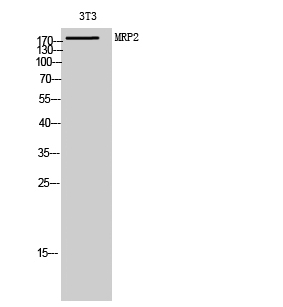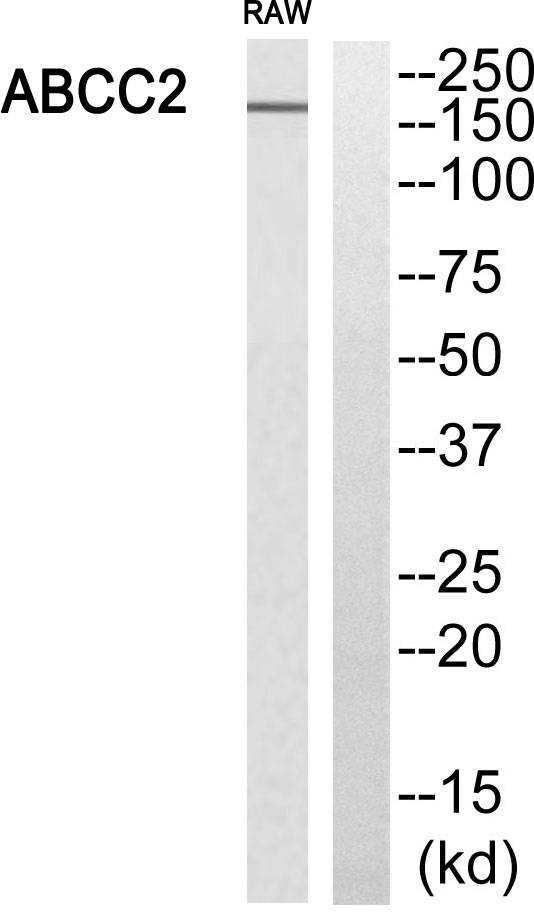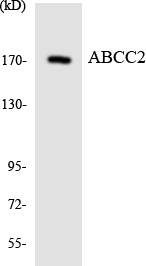MRP2 Polyclonal Antibody
- Catalog No.:YT2840
- Applications:WB;ELISA
- Reactivity:Human;Rat;Mouse;
- Target:
- MRP2
- Fields:
- >>Antifolate resistance;>>Platinum drug resistance;>>ABC transporters;>>Bile secretion
- Gene Name:
- ABCC2
- Protein Name:
- Canalicular multispecific organic anion transporter 1
- Human Gene Id:
- 1244
- Human Swiss Prot No:
- Q92887
- Mouse Swiss Prot No:
- Q8VI47
- Immunogen:
- The antiserum was produced against synthesized peptide derived from human ABCC2. AA range:991-1040
- Specificity:
- MRP2 Polyclonal Antibody detects endogenous levels of MRP2 protein.
- Formulation:
- Liquid in PBS containing 50% glycerol, 0.5% BSA and 0.02% sodium azide.
- Source:
- Polyclonal, Rabbit,IgG
- Dilution:
- WB 1:500 - 1:2000. ELISA: 1:10000. Not yet tested in other applications.
- Purification:
- The antibody was affinity-purified from rabbit antiserum by affinity-chromatography using epitope-specific immunogen.
- Concentration:
- 1 mg/ml
- Storage Stability:
- -15°C to -25°C/1 year(Do not lower than -25°C)
- Other Name:
- ABCC2;CMOAT;CMOAT1;CMRP;MRP2;Canalicular multispecific organic anion transporter 1;ATP-binding cassette sub-family C member 2;Canalicular multidrug resistance protein;Multidrug resistance-associated protein 2
- Molecular Weight(Da):
- 175kD
- Observed Band(KD):
- 190-250kD
- Background:
- The protein encoded by this gene is a member of the superfamily of ATP-binding cassette (ABC) transporters. ABC proteins transport various molecules across extra- and intra-cellular membranes. ABC genes are divided into seven distinct subfamilies (ABC1, MDR/TAP, MRP, ALD, OABP, GCN20, White). This protein is a member of the MRP subfamily which is involved in multi-drug resistance. This protein is expressed in the canalicular (apical) part of the hepatocyte and functions in biliary transport. Substrates include anticancer drugs such as vinblastine; therefore, this protein appears to contribute to drug resistance in mammalian cells. Several different mutations in this gene have been observed in patients with Dubin-Johnson syndrome (DJS), an autosomal recessive disorder characterized by conjugated hyperbilirubinemia. [provided by RefSeq, Jul 2008],
- Function:
- disease:Defects in ABCC2 are the cause of Dubin-Johnson syndrome (DJS) [MIM:237500]. DJS is an autosomal recessive disorder characterized by conjugated hyperbilirubinemia, an increase in the urinary excretion of coproporphyrin isomer I, deposition of melanin-like pigment in hepatocytes, and prolonged retention of sulfobromophthalein, but otherwise normal liver function.,function:Mediates hepatobiliary excretion of numerous organic anions. May function as a cellular cisplatin transporter.,similarity:Belongs to the ABC transporter family. Conjugate transporter (TC 3.A.1.208) subfamily.,similarity:Contains 2 ABC transmembrane type-1 domains.,similarity:Contains 2 ABC transporter domains.,tissue specificity:Found on the apical membrane of polarized cells in liver, kidney and intestine. The highest expression is found in liver.,
- Subcellular Location:
- Apical cell membrane ; Multi-pass membrane protein .
- Expression:
- Expressed by polarized cells in liver, kidney and intestine. The highest expression is found in liver.
The potentially protective role of ATP-binding cassette transporters in preeclampsia via Nrf2. Pregnancy Hypertension-An International Journal of Womens Cardiovascular Health WB Human placental
- June 19-2018
- WESTERN IMMUNOBLOTTING PROTOCOL
- June 19-2018
- IMMUNOHISTOCHEMISTRY-PARAFFIN PROTOCOL
- June 19-2018
- IMMUNOFLUORESCENCE PROTOCOL
- September 08-2020
- FLOW-CYTOMEYRT-PROTOCOL
- May 20-2022
- Cell-Based ELISA│解您多样本WB检测之困扰
- July 13-2018
- CELL-BASED-ELISA-PROTOCOL-FOR-ACETYL-PROTEIN
- July 13-2018
- CELL-BASED-ELISA-PROTOCOL-FOR-PHOSPHO-PROTEIN
- July 13-2018
- Antibody-FAQs
- Products Images

- Western Blot analysis of 3T3 cells using MRP2 Polyclonal Antibody diluted at 1:1000

- Western blot analysis of ABCC2 Antibody. The lane on the right is blocked with the ABCC2 peptide.

- Western blot analysis of the lysates from HeLa cells using ABCC2 antibody.



